History & Politics
Pressing On
A year after the mass shooting, the Capital Gazette staff and family members have not moved on. They’ve kept on.
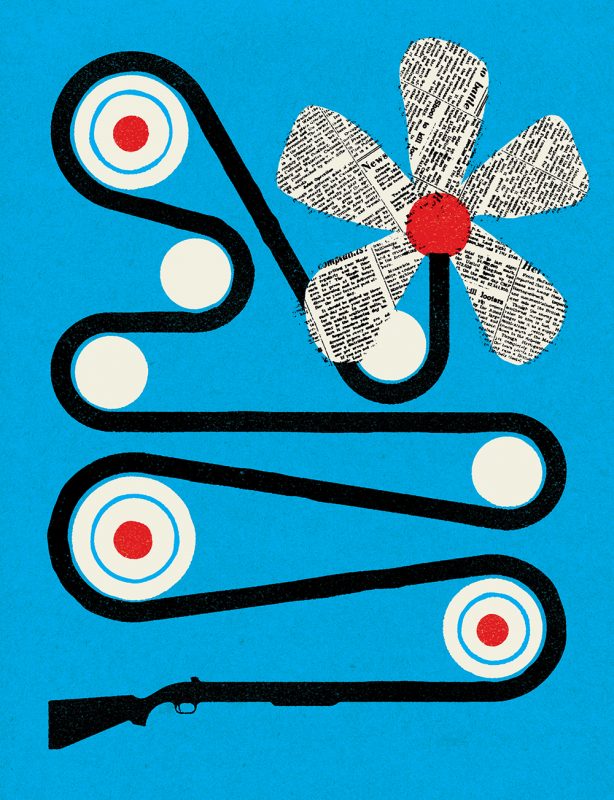

ix months after five of his colleagues were gunned down in front of him in his Annapolis office, days off were still the hardest for Capital Gazette photographer Paul Gillespie.
When his wife wasn’t around and he “started thinking about things,” they got even worse as his mind drifted back to the afternoon of June 28, 2018 and the brutal deaths of Gerald Fischman, Rob Hiaasen, John McNamara, Rebecca Smith, and Wendi Winters. One moment Gillespie had been editing photos of an Anne Arundel County crew pulling up stormwater piping, the next he was hiding, terrified, beneath his desk. During a break in the shotgun blasts, Gillespie had raced past Winters’ prostrate body and through the newsroom’s shattered glass doors, yelling for help at a nearby bank.
A half a year later, he was unable to get much done unless he was on an assignment for work, passing the hours at home staring at the television and surfing the internet. He was sinking further into depression, and he knew it.
A documentary he caught about the austere, black-and-white portrait work of British photographer Platon Antoniou eventually offered a flicker of creative inspiration and a small promise of relief. Gillespie decided he’d make some portraits in a style similar to the simple set-up Antoniou utilized in his celebrity portraiture. He cleaned out a makeshift studio space in his basement. Then he wondered, “Who can I get to sit for me?”
When Time named the Capital Gazette team a “Person of the Year” and pulled the staff together for their December cover image, Gillespie was reminded how much he loved his colleagues. He asked a few of them to sit first. Fellow photographer Joshua McKerrow came over and posed with one of his own cameras. Reporter Pat Ferguson placed a baseball cap with the words “Not the Enemy” on the table in front of him. Reporter Chase Cook—whose tweet, “I can tell you this: We are putting out a damn paper tomorrow,” went viral an hour after the mass shooting—held a copy of their newspaper. Others, too, stopped by and sat for Gillespie.
Twenty-year-old Summerleigh Winters Geimer, wearing a “Journalism Matters” T-shirt, brought a graduation picture with her deceased mother. So far, Gillespie’s ongoing project: “Journalists Matter: Faces of the Capital Gazette,” includes more than a dozen and a half portraits.
“I borrowed the idea from Platon, but I’d like to think I’ve made it my own. For one thing, my basement ceiling is only 7 feet, so everyone’s sitting in my portraits,” Gillespie says with laugh. “I’ve tried to capture who each person is and bring that out. It’s been a creative outlet and something I have complete control over, which feels good.
“They’ve also been therapy sessions,” Gillespie acknowledges. “We started talking about the portrait and we end up talking about that day.”
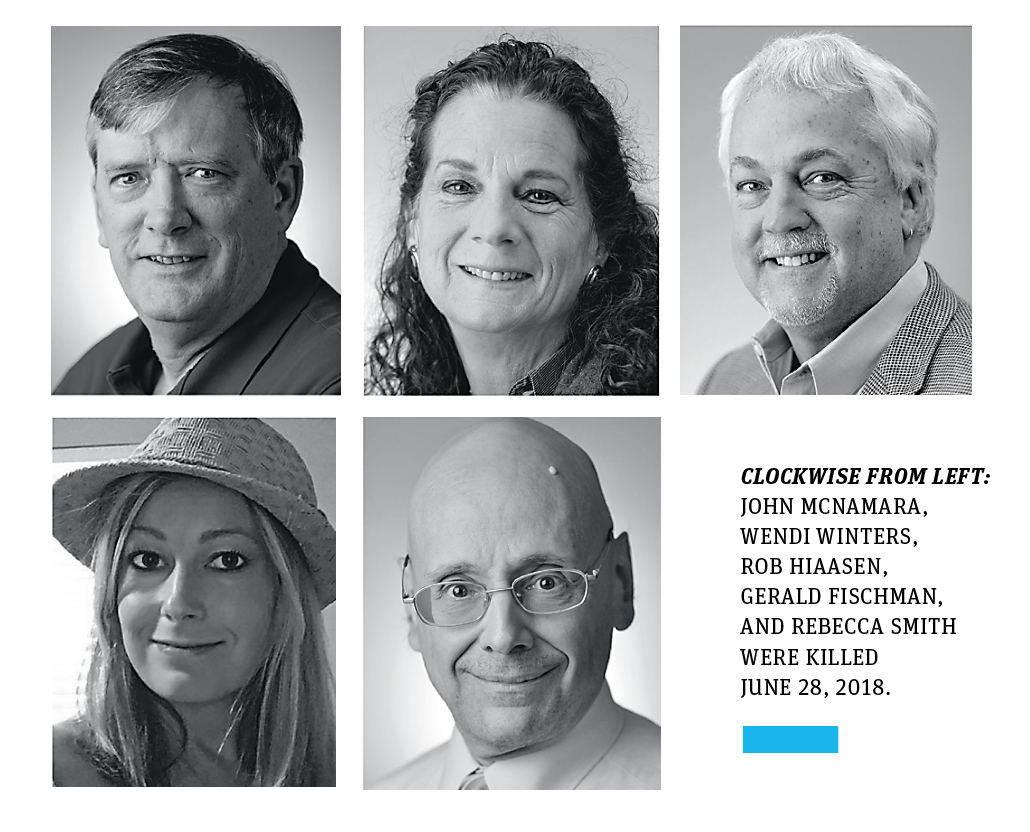
The evening after the single deadliest attack on American journalists in recent history, hundreds of Anne Arundel County readers and residents walked in a candlelight vigil for the shooting victims down historic Main Street in Annapolis. Hundreds more attended the heartbreaking memorials and services for Fischman, Hiaasen, McNamara, Smith, and Winters. In the days that followed, editor Rick Hutzell pulled an already tight-knit newsroom even closer together. Despite their own shock and suffering, they kept reporting on local law enforcement efforts, the suspect’s complicated history with the paper, and the community’s outpouring of grief. They penned heart-wrenching first-person recollections of their colleagues and kept reporting the news, too, earning a Pulitzer citation for their courage and compelling journalism in the wake of the horrific tragedy.
Hutzell called the Pulitzer “a great and terrible honor.”
Led by some of its young staffers, Capital reporters and photographers have not only managed to put out a great local newspaper every day since last June, but form a union, the Chesapeake News Guild, winning volunteer recognition from Tribune Publishing. Through it all, they’ve pressed on through near-constant reminders of their loss and trauma.
“I don’t like the phrase ‘moving forward,’” says Cook after covering the funeral of longtime Maryland Speaker of the House Michael Busch, who passed away toward the end of the 2019 General Assembly. “I’m an Annapolis reporter, and I have to be here, but covering this funeral made me think about the five other funerals I attended for my friends this past year.
“You find a way to keep going because you have no other choice.”
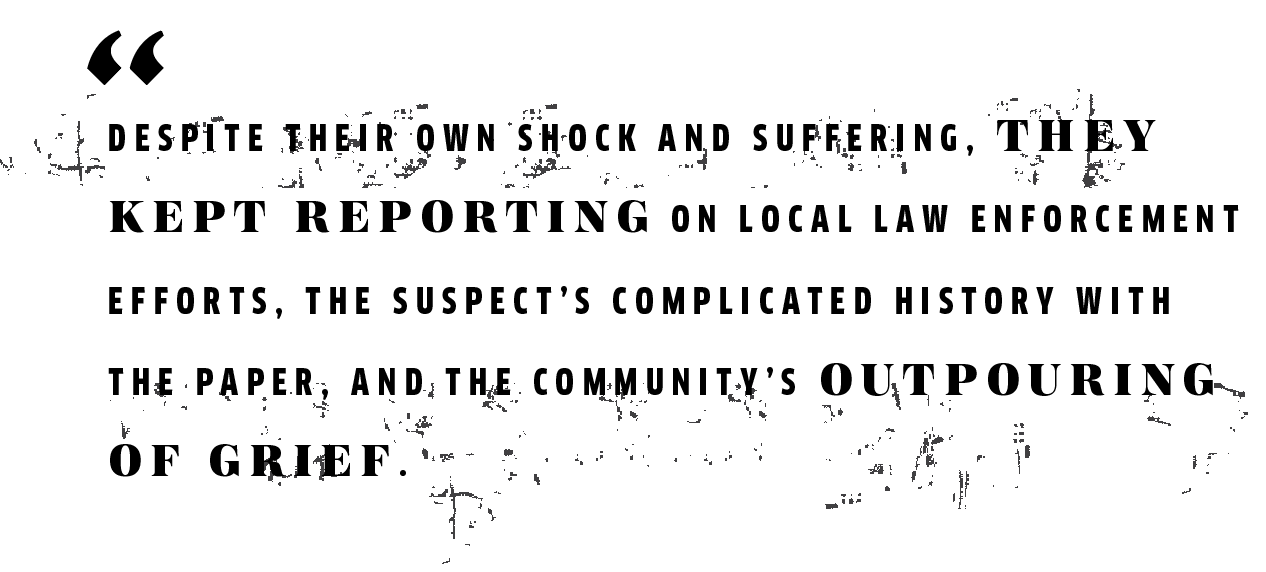
Those killed in the attack of the 135-year-old newspaper were four veteran journalists and Capital editors and Smith, a sales assistant who sat near the front door and was admired for her kind nature. Whether the editors were specifically targeted among the staff remains unknown. (The suspect, whose trial has been pushed to November, held a deep grudge against the paper, but it was linked to a lawsuit that named a former columnist and former editor who are no longer there.) Gerald Fischman, a quiet, exacting professional with a wickedly dry sense of humor, was the longtime editor of The Capital editorial page and “the best writer I have ever had the privilege to know,” reporter Danielle Ohl says. Writer and editor Rob Hiaasen, who previously worked as a feature reporter at the Baltimore Sun, was probably the best known of Capital journalists among Maryland media circles. Older Sun colleagues recall Hiaasen’s humor, storytelling ability, and deft touch on the page; younger colleagues gush about the 6-foot-5 gentle giant’s intelligence and light touch as an editor and mentor. John McNamara, a dedicated, old-school journo and obsessed local sports fan—he authored books about the history of the University of Maryland football and basketball programs—most recently served as the jack-of-all-trades editor of the Bowie Blade-News and the Crofton-West County Gazette. Wendi Winters knew everyone in Annapolis and everyone knew her.
The daughter of a Naval Academy graduate and mother of four, including three Navy officers, Winters led a Girl Scout troop, participated in Unitarian Universalist Church of Annapolis activities, and organized biannual blood drives. Journalism had been her third vocation, following careers in fashion and public relations. She found her calling as a community reporter, which she did on a freelance basis for more than a decade before The Capital finally hired her fulltime. She wrote “Teen of the Week” and “Home” columns, and pointed readers to overlooked, and sometimes secret, spaces and places in her “Off Limits” series.
Incredibly, the 65-year-old Winters grabbed her trash can and recycling bin and charged the shooter, likely saving the lives of several of her 11 colleagues in the office at the time of the attack. Just weeks before, Winters had taken an active shooter training at her church, where a police officer presented the options: Run, if possible. Hide, if not. And finally, fight only as a last resort to save yourself and others. Maryland’s Capitol Hill delegation, including retired Sen. Barbara Mikulski, formally requested that the White House award Winters the Presidential Medal of Freedom. (Not surprisingly, given the current occupant of the White House’s hostility toward the press, Maryland’s congressional delegation has not yet received a response.)
Janel Cooley, a sales consultant, told The Capital that Winters shouted, “No! You stop that!” or “You get out of here!” as if she were shooing a bully from a schoolyard. At an Annapolis blood drive earlier this year in Winters’ honor, which brought in hundreds of donors, 25-year-old Montana Geimer said she was not surprised by her mother’s actions. “She wanted to protect her co-workers. That’s who she was,” Geimer says. “So many people who I don’t even know have come up and told me stories about my mom.”
“It just rang true to me when I read what she said [to the attacker],” Geimer continues, adding with a smile through some tears, “I’ve heard that voice before.”
As Winters’ children are honoring their mother through their volunteer work with the blood drives, Rob Hiaasen’s wife, Maria Hiaasen, and John McNamara’s, Andrea Chamblee, are honoring their deceased husbands by getting their literary passion projects published. Hiaasen’s first novel, Float Plan, was released last fall by Loyola University’s Apprentice House Press. A collection of his columns is due to be published June 28, which the General Assembly unanimously named “Freedom of the Press Day” in recognition of the fallen journalists.
Hiaasen spent years on the book (his older brother, Carl, is an accomplished novelist), writing on nights and weekends in his Timonium home. In the car, on vacation, between work, he filled notebooks and Post-its with scratches about the characters, amalgamations of him and his wife and people they knew.
“It brings a lot of joy to me and our children in seeing the fulfillment of Rob’s dream—and our dream for him, but it’s bittersweet,” says Maria Hiaasen. “He should be here for this.” The novel, she adds, tells the story of math teacher Will Larkin, who in one disastrous year loses his marriage, job, boat, and basset hound. A “float plan” is literally a written plan that boaters like Hiaasen, who grew up in Florida, file with a reliable person or rescue agency in case something goes awry. The title is a metaphor for surviving “the loss of the thing you care about the most,” says his wife. “And we lost him. It turns out he left us instructions how to manage. But it doesn’t change the fact the house is empty when I get home from work, and I still wait for him. Or that, for the first time, I’m not looking forward to the end of the school year because I will be alone this summer.”
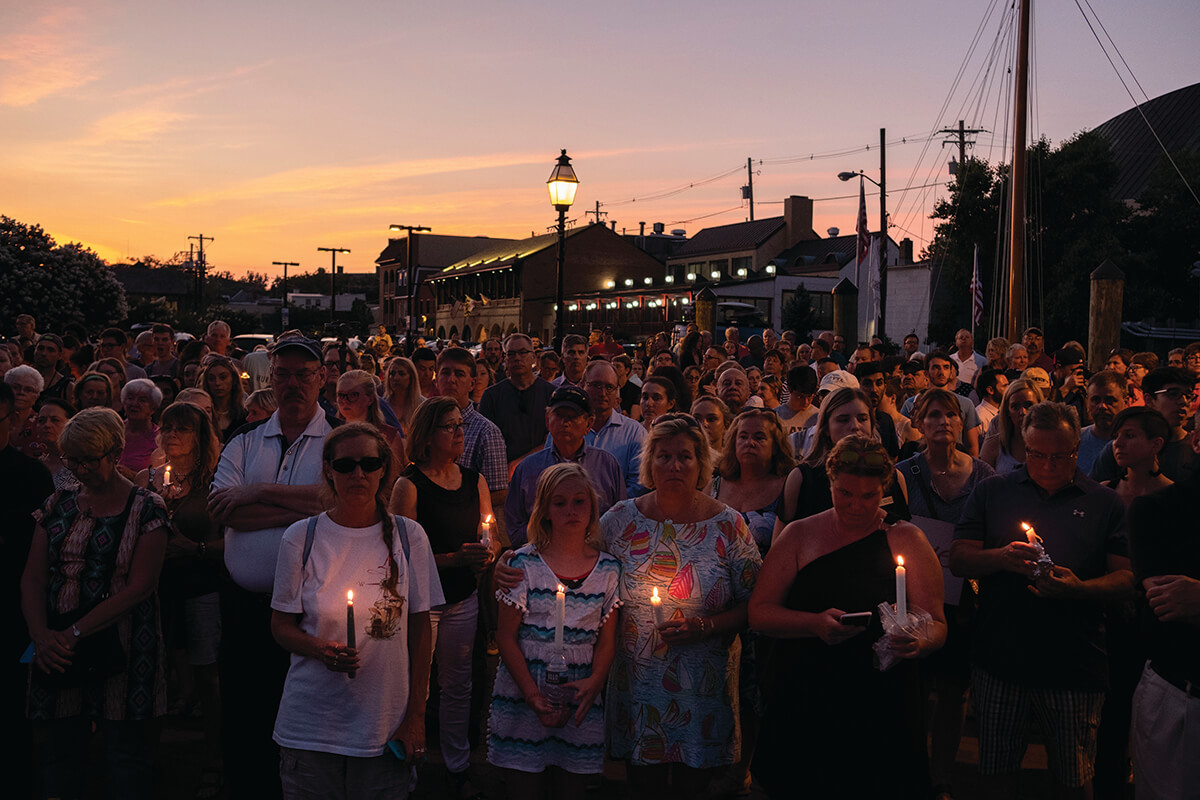
Chamblee, an FDA attorney, is getting her husband’s final labor of love, a collection of Washington, D.C.-area hoop stories and photographs, published this fall through Georgetown University Press. Similarly, Erica Fischman, who recited a selection of her husband Gerald’s poetry at his funeral, has said she’s considering organizing a collection of her husband’s poems.
Hiaasen and Chamblee have also turned their grief into political action. Both have become outspoken gun violence prevention advocates, fighting this past General Assembly to close a long gun loophole that could’ve prevented future murderers from legally purchasing the pump-action shotgun used at the Capital Gazette. Rachel Pacella, who covers Bowie and the environment and survived the shooting, made a difficult decision for a journalist and also testified on behalf of the bill. It did not pass, however. “The way I feel about the advocacy is that I want to prevent the next family from going through what we did,” Chamblee says, adding she and her husband counted the days to their retirement together daily—“March 21, 2021—1,008 from the day he was killed.”
“The vision John and I had for our future was blown up. Needlessly,” Chamblee says. “These gun deaths are needless, that’s part of what makes it so painful.” Both Hiaasen and Chamblee were named vice-chairs of Anne Arundel County’s Gun Violence Prevention Task Force by County Executive Steuart Pittman.
“What happens,” says Hiaasen, a former journalist who met her husband when both worked at the Palm Beach Post, “is you become a member of a club you never wanted to belong to. I can’t tell you how many people I’ve met who’ve told me about a family member or friend who was shot. Sometimes it’s a sibling. Sometimes it’s a girlfriend who was a victim of domestic violence.” Two members of the gun violence survivors network Hiaasen met at a forum at the National Cathedral in Washington this year were the parents of Alison Parker, the Virginia television news reporter killed along with photographer Adam Ward in 2015. It was just one more reminder, she says, that journalists are working in an ever more fraught environment today.
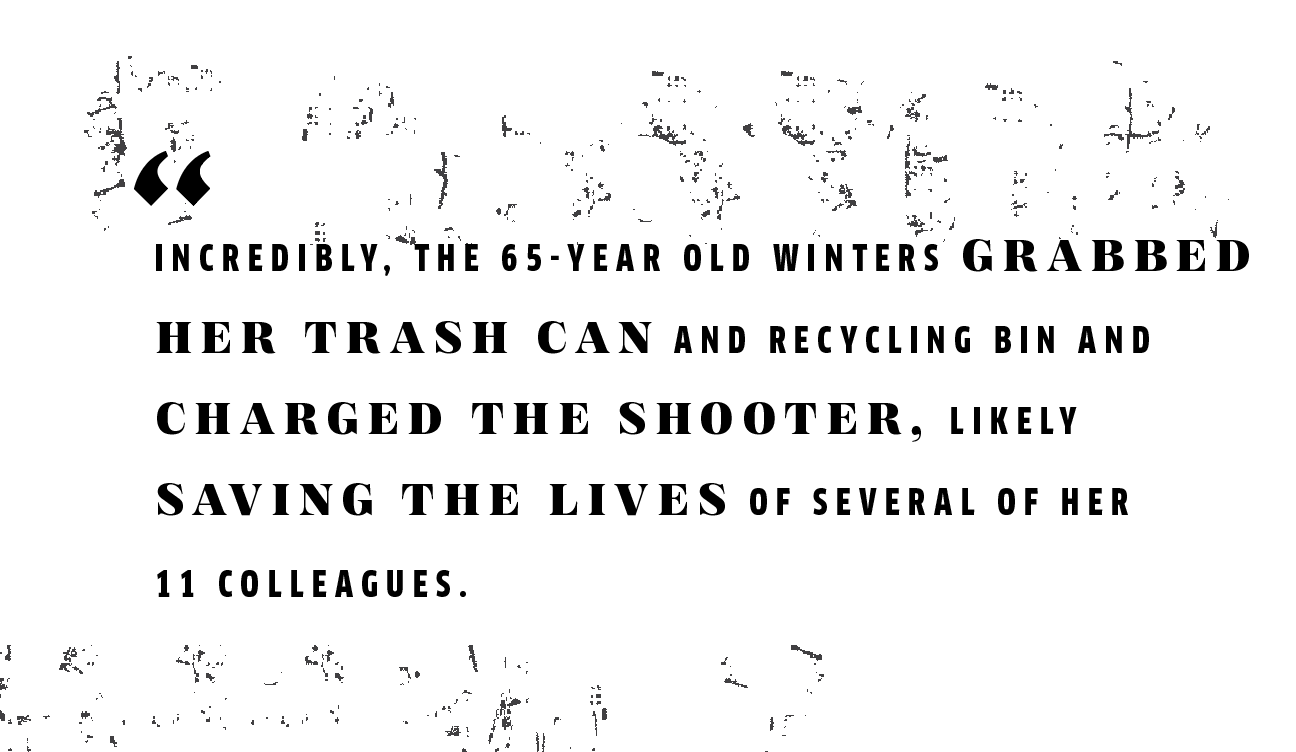
The killing of five American newspaper employees reverberated around the world last summer because it targeted the press specifically, standing out among the epidemic of mass shootings long plaguing the country. In turn, it placed the Capital Gazette staff, used to reporting events, including murders and trials, squarely in the middle of not one, but two issues dividing us like no others over the past few years. The first is the epidemic-level of gun violence and mass shootings, and the inability of elected leaders to address a crisis that killed nearly 40,000 people, including suicides, last year.
The second, more recent, is the rhetoric from the contentious president of the United States, who habitually directs tirades at journalists.
Donald Trump’s “enemy of the people” characterizations of the press and occasional incitements of violence at his rallies can’t help but create an environment in which individuals with violent tendencies are more likely to lash out against the press, says CNN’s media critic Brian Stelter, a Maryland native, who has closely followed the Capital Gazette shooting. Case in point: The Silver Spring U.S. Coast Guard lieutenant arrested earlier this year while plotting a massive attack was a white nationalist who had MSNBC and CNN media personalities on his hit list. Same for the Florida man arrested for planning bomb attacks this past fall. More recently, there was an assault of a press cameraman at a Trump appearance. It’s a frightening enough combination of events that CNN and other news media outlets now employ security guards to protect reporters covering the president’s rallies.
“Almost everything Trump says about the media Nixon said, but he did so privately,” Stelter says, referring to secret White House recordings later made public through the Watergate hearings. “It’s unlike anything in our lifetimes.”
Out of concern for their security, the Capital Gazette staff moved into a new location after the shooting, which they do not publicly disclose.
Not much is known about the reason for the timing of the shooter’s sudden outburst. His original complaint against the newspaper centered on a 2011 story that covered his criminal harassment of a female former high-school classmate. In 2012, he filed a defamation lawsuit against then-columnist Eric Hartley, Capital Gazette Communications, and the paper’s then-editor and publisher Thomas Marquardt. Prosecutors in the shooting case have been playing their cards close to vest, but it has been reported he visited right-wing conspiracy websites.
McKerrow, the photographer, is frustrated by the dearth of information coming in regarding the shooter’s motives. But he also understands prosecutors want to be able to make their case to an untainted jury. “I’m hesitant to talk about the trial, I think most of us are, although we are certainly following it closely,” he says. “I’m not going to say Donald Trump set him off,” McKerrow adds. “I don’t know what did. But it is interesting that we hadn’t heard anything from him [the suspect] for years and then, all of sudden, he goes off. Do I want to know why? Yes.”
Cook and Ohl, meanwhile, are tasked with covering the trial and then potentially a sentence hearing that would likely include testimony from colleagues and former colleagues’ spouses and adult children. “We’re professionals, we cover trials, and we can set aside our personal interests,” Cook says. “That said, it’s a high-profile trial, and our own memories are still very raw.” As a journalist, he adds that he’s always thought of himself as compassionate and empathetic—“we’re used to talking to people at the worst moments in their lives”—but the experience has changed his perspective. “Until you go through some things, you can’t really understand it.”
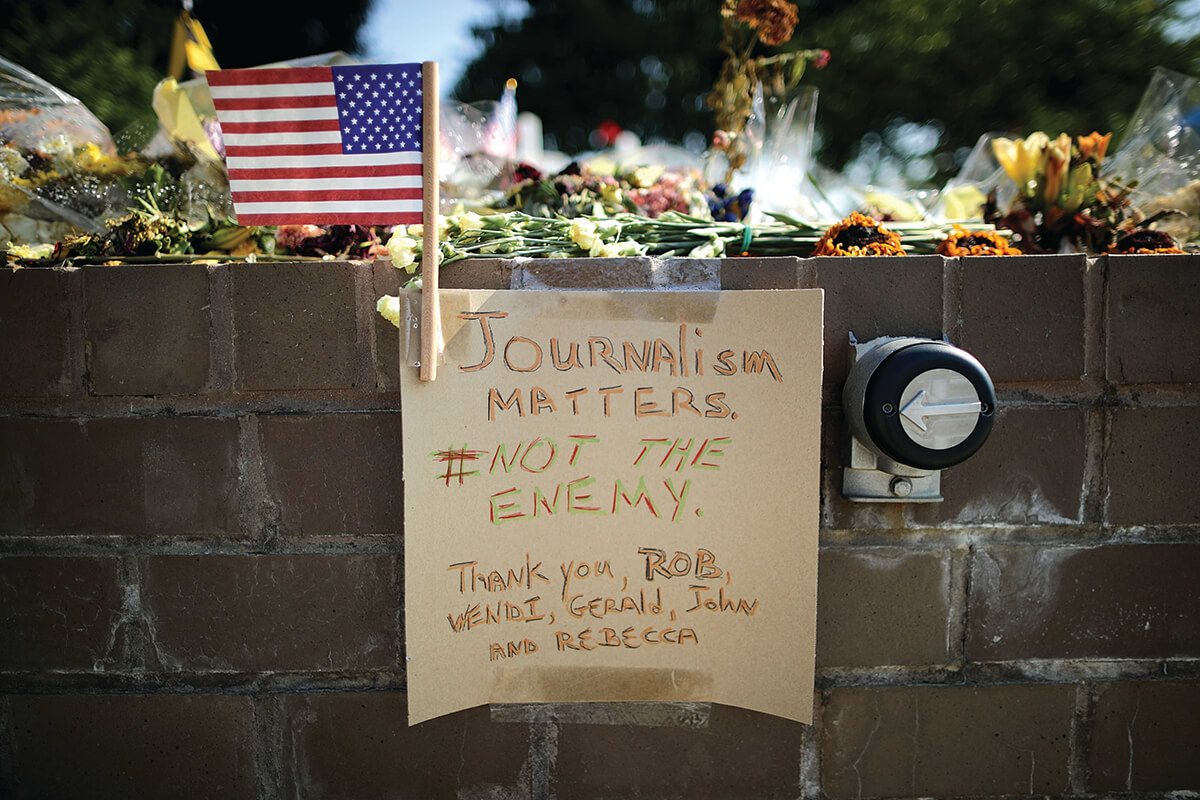
If anything, the tragedy has made the survivors more committed to truth-telling journalism. Former Capital Gazette staffers and colleagues from newspapers around the country, including the Los Angeles Times, Allentown Morning Call, Delaware News Journal, Virginian-Pilot, and The Baltimore Sun, returned for three, four, and five days at a clip, and longer, to lend a hand in the weeks and first months following the shooting. Readers expressed their support for their commitment in the best way possible—buying 800 new subscriptions in the days after the tragedy.
The only staffer to leave over the past year is reporter Phil Davis, who essentially took a promotion to The Sun, which is also owned by Tribune Publishing.
Late last summer, a group of 30-plus Capital Gazette staff and local alumni, who have referred to themselves as the Rolling Donut Society since the mid-’80s, gathered to eat crabs at Hutzell’s home in a show of solidarity.
“We took a pause with forming the union for a few months,” Ohl says. “We had to ask ourselves, ‘Is this the right time to do this?’ We had a lot on our plates. More than usual. Although we got help, which was so appreciated, we felt overwhelmed at times, too. In the end, we want to ensure this newspaper remains, these jobs remain, and the work that Rob, John, Wendi, Gerald, and Rebecca did continues. The best way to do that is to fight for livable wages and good benefits and working conditions.”
And today, the job of reporting the news is both more difficult and more meaningful.
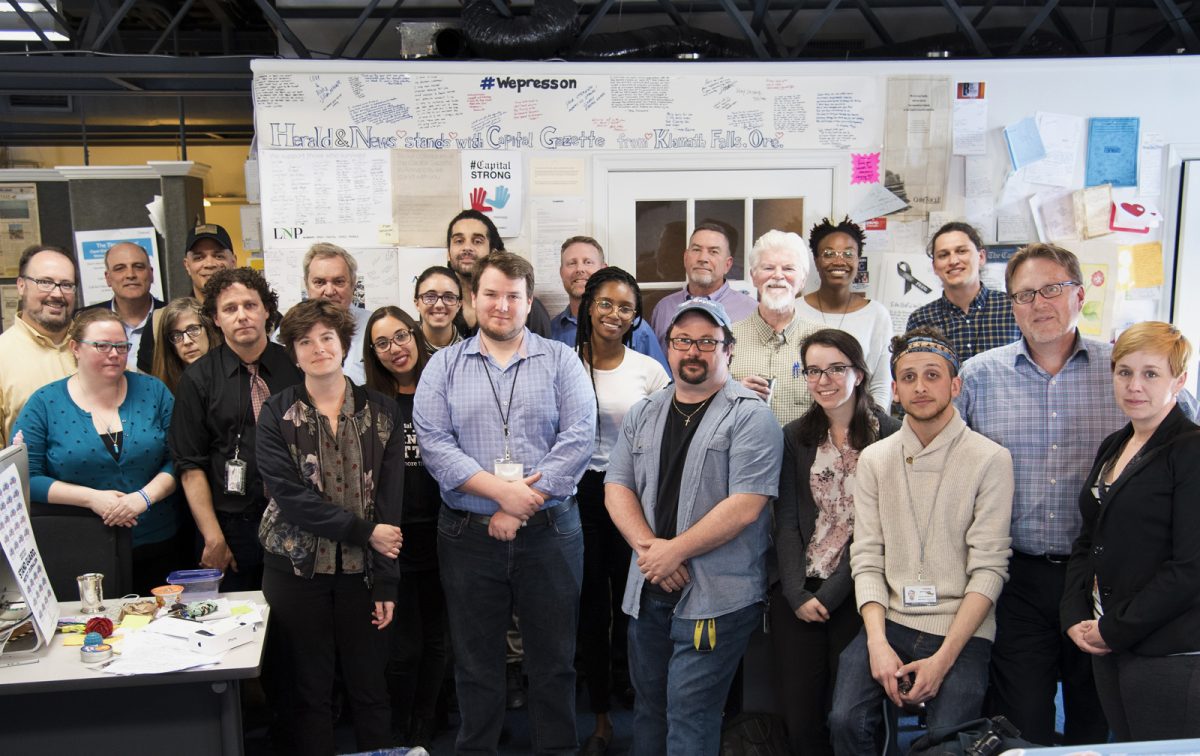
McKerrow, who was particularly close to Winters, assumed his friend’s role as the dispenser of the newsroom’s weekly most valuable player award—a cheap, 5-inch newspaper boy in golden trophy form—and $5 gift certificate for coffee.
Late last year, he shot the paper’s annual holiday decorations feature at the Governor’s residence. For years, it was a light yet fun story he did with Winters, his reporting partner, who loved such occasions and always remained awed by the majesty of the day. This past December, his partner was colleague Selene San Felice, who was in the office the day of the attack.
McKerrow tried to hold it together throughout the day, but ended up crying to himself in the Governor’s Mansion. Late that evening, after he got home, he saw Donald Trump had fired off another all-caps tweet: “FAKE NEWS-THE ENEMY OF THE PEOPLE!”
What had provoked the tweet, McKerrow did not know. It appeared to him another random broadside. He responded with a thread, essentially recounting his experience that afternoon and how much he missed his patriotic former colleague Winters, killed by a man trying to silence journalists. It received hundreds of thousdands of responses.
“This has been tough for everybody here,” says McKerrow, sharing that he has been diagnosed with post-traumatic stress disorder. “This is what I know. You don’t heal from something this like you heal from a broken arm. You carry it with you. You have to adapt and you have learn how to do that. I think most of us are still learning how to do that.”